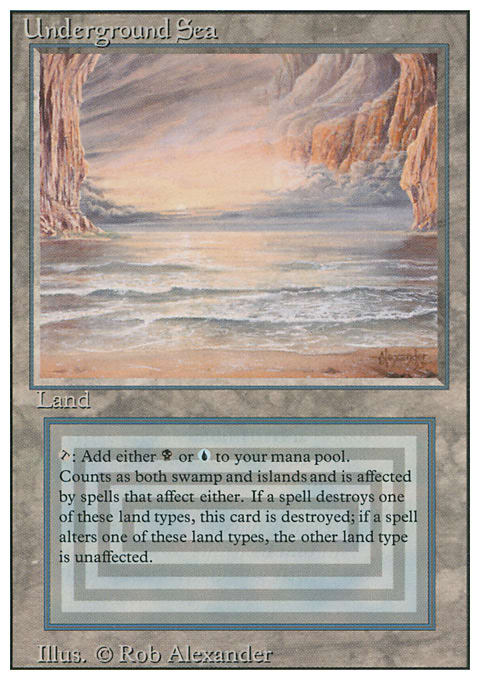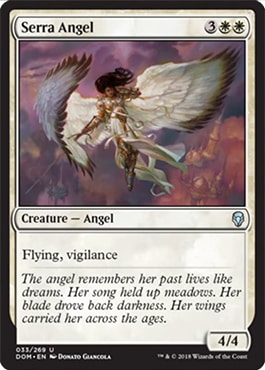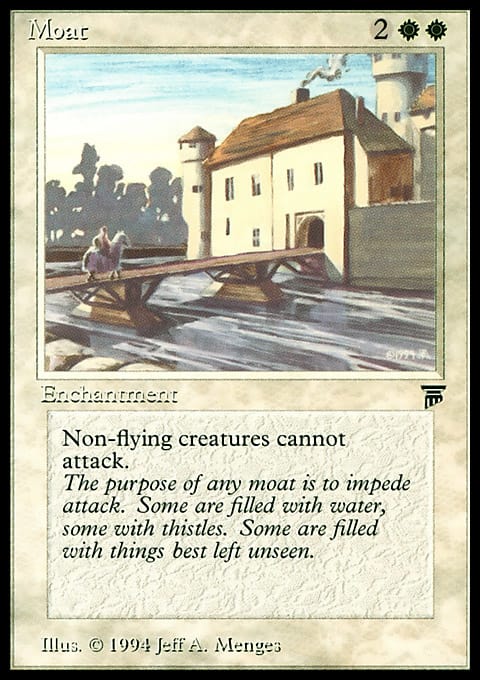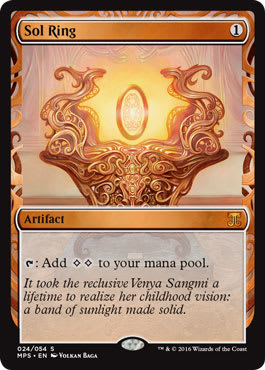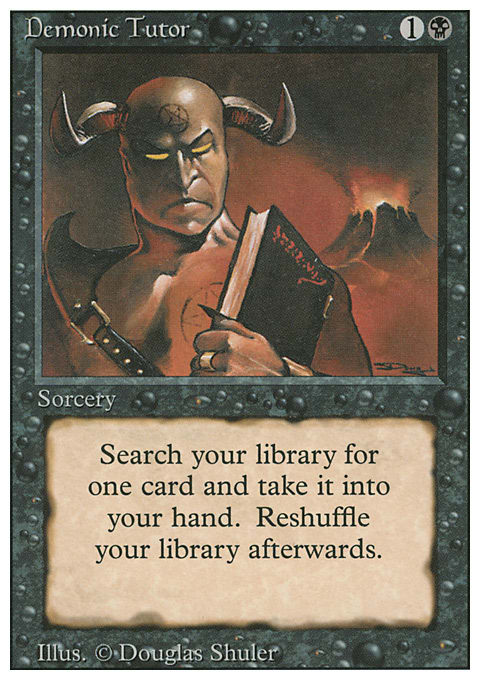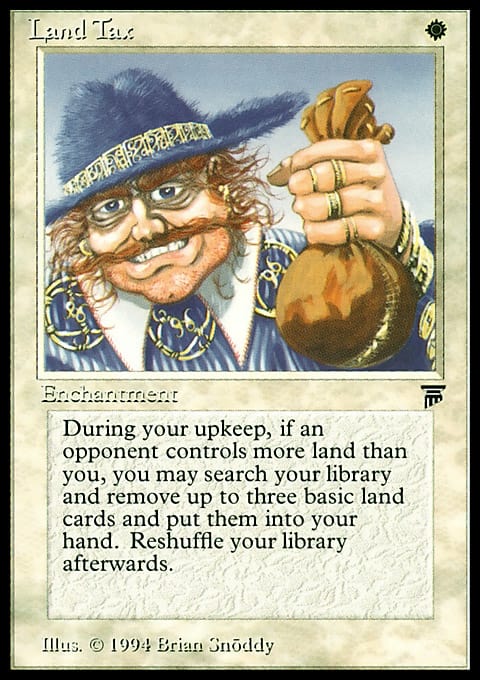I've recently encountered a lot of friends who have uncovered old Magic collections. Many played the game a long time ago and are not interested in coming back into the game, but they are wondering what their collections are worth. Maybe a friend gave you his collection back in 1996 and you have no idea what its value is.
Meanwhile, we have a lot of folks out there who have come back from playing a long time ago, and they have small collections with a few decks from the early days of Magic.
I have been helping some of them understand the basics of Magic finance today. Particularly, I am walking them through why some of their cards are worth very little today while others have been huge hits.
I wanted to write a quick primer that aims to bring folks up to speed. It's not geared toward most players, as it simply overviews financial changes, reprints, and such for older cards. But if you looked up and were surprised to see how little a card is now worth, or how much it's risen, this should be a fun article for you!
More importantly, this should help you get a better handle on if you should sell!
The basic state of Magic finance in 2014 is much different than how cards used to be valued, particularly those printed in the first two and a half years of Magic through the end of 1995. (For those keeping track of stuff in the back, that means all cards through Homelands.)
Most of the cards printed from 1993 to 1995 were in sales runs that were sold out fairly quickly, and they were low runs. (Exceptions include stuff like Fallen Empires and some later sets.) Today, the number of people has greatly increased. There are more people playing Magic today than played World of Warcraft at its height. It's big stuff.
So, the large number of people combined with the relative scarcity of cards from this era should equate to high prices for those of you holding onto cards from your playgroup. Right?
Well, not usually.
Some cards have held up remarkably well. And we have a few that have been huge financial hits out of nowhere. And that's great! But most just aren't worth that much.
I'm sure you are familiar with the ins and outs of card gaming. Cards that are better, either for tournaments or casual play, generally tend to be worth more than those that are not. Given the same supply, the demand will increase for the better card, and its price will rise. Yay good card!
The problem is that most of the strong cards from this era just have been left behind. There has been some power creep—intentionally. The developers felt that creature combat was the core of the game, but creatures weren't good enough. Over the years, we've seen a huge upswing in the power level of creatures. Therefore, early cards that had a lot of power, particularly creatures, have been antiquated. In fact, virtually all of the good early creatures have been reprinted multiple times and have very little value—Hypnotic Specter, Clone, Shivan Dragon, Erhnam Djinn, Juggernaut, Mahamoti Djinn, Serra Angel, and Sengir Vampire have all been reprinted so frequently that they have no real value on the market above a few coins.
The best example of this is probably Savannah Lions, once pulled from the core set for being too good as a rare 2/1 for 1 mana with no drawback. Today, you can find a recently printed card like Soldier of the Pantheon, which is a 2/1 for 1 with two useful abilities. Meanwhile, Savannah Lions was reprinted as an uncommon in a later core set, so its value tanked. There's not a lot of demand for the Lion today.
And this is true of a lot of cards of the era. Because demand has dropped, there is not the same value for the scarcity.
So, what cards have value?
If a card is really good in a format like Vintage or Legacy, or is a bedrock staple in a casual-only format called Commander, its value may be considerable. Cards like Moat, The Abyss, and the original ten dual lands, have really high prices. These were heavy players from the era; there's no surprise to see them still punching above their weight classes.
There are some reasons a lot of individual cards dropped in value, so let's take a look at some specifics:
Reprints in a Set – A ton of early cards were reprinted in later sets during the Modern era. Fireball has been reprinted. Lightning Bolt was a common in a core set. Birds of Paradise has been in a ton of sets. Even a powerhouse like Swords to Plowshares was an uncommon in a set as recently as this past summer (Conspiracy). Many cards made it to main sets. A lot of cards from this era that had value in part due to scarcity have been reprinted. For example, cards such as Twiddle, Rukh Egg, Dwarven Demolition Team, and Invisibility were all worth a few bucks because they had seen limited printings in the first few sets of the game; all made the cut in later sets.
Reprints as a Premium Card – Meanwhile, a lot of cards were reprinted as foils. Even cards on the Reserved List were reprinted in a premium state for years. (The Reserved List is a list of cards that Wizards of the Coast vowed to never again reprint. The premium versions of cards seeing another day in the sun has since ended.) Cards such as Maze of Ith, Balance, Berserk, and Serendib Efreet have been reprinted as premium cards. This reduces the value of the printed ones because more product hits the market. However, many cards from this still are worth something. Maze of Ith dropped after its printing, but it's still worth a lot of money.
Reprints in a Constructed Deck – Today, Wizards of the Coast releases a ton of decks that are prebuilt. Most feature cards from the last year or three. However, some of these decks have printed cards from the early era. Some of the best hitters from this era that were too good to be printed in a normal set (because of how it would negatively impact Standard) have since been released in these standalone products. The standard for stealing creatures has always been Control Magic, which used to be a few dollars. Last December, it was printed as a one-of in a Commander deck, putting a lot of those cards on the market. Meanwhile, Nevinyrral's Disk was also in a deck. Ten times, we've seen Sol Ring in these decks, and it's been a premium card, too. Despite the fact that it's arguably the most vital of the Commander essentials, its mass production in the last few years has kept the price of it reasonable. Cards such as Basalt Monolith, Rubinia Soulsinger, Dark Ritual, and Night Soil have all hit these products.
Too Limited – Many of the cards from the early era of Magic are overly specialized and appeal to only a tiny subset of Magic players. They just aren't that good. Cards like Sorrow's Path, Lifelace, and Active Volcano just are too limited in scope. You have to really push them in a deck to make them work.
Too Weak – Meanwhile, early developers were often afraid to make something too powerful. They dialed back cards’ power or casting costs so much that it's basically unusable. The best example of this, ever, is Obelisk of Undoing. There are a ton of players today trying to intentionally bounce their own stuff. This is a pretty useful ability that has a home in modern decks. But Wizards was clearly afraid of it then, so they made it cost 6 mana to activate. Plus, it taps the artifact, too, so it can only be used once, and just on your own stuff. That's way too weak. They nerfed Time Elemental (because bouncing was scary so you couldn't bounce a card that was enchanted). Take a look at cards from Rakalite to weak stuff like Bronze Horse that just were not that good because they were overly brought down. Worms of the Earth might have been interesting, so let's make sure your opponent has two ways to destroy it built into the card.
That means we have a lot of cards that were too weak, were too limited in scope, have been antiquated by power creep, or have been subsequently reprinted. Those are a lot of reasons that cards just don’t have a lot of value, despite the low print runs.
To be fair, the fact that a card was reprinted does not mean it's not worth anything. Cards like Demonic Tutor, Swords to Plowshares, and more still have some value. Based on condition and set, Swords to Plowshares is still in the $3 to $4 range right here at CoolStuffInc.com. Wrath of God is $5 to $6. Llanowar Elves is between a quarter and $0.50. Lightning Bolt is still around $2.
Meanwhile, cards that hit and were not reprinted have been major hits. If you own a dual land, depending on condition and the colors, it's worth quite a bit of money. Some are worth more than $100, with Underground Sea in the high $200s to the low $300s. Others, such as Taiga or Scrubland, are a lot less but still worth quite a bit of sauce. Cards like Moat, Mana Drain, The Tabernacle at Pendrell Vale, Bazaar of Baghdad, Diamond Valley, Karakas, and Candelabra of Tawnos are just worth an undeniably incredible amount of cash.
If you have a Commander staple, you could have a card that is in high demand by casual Commander players with limited print runs. This can drive the price of a few unusual older cards as well. Angus Mackenzie is a perfect example, with a copy netting you $69 for a near-mint one. Many of the best, iconic, and fun legends are also worth a splash of cash: Dakkon Blackblade, Gwendlyn Di Corci, Hazezon Tamar, Rasputin Dreamweaver, and Adun Oakenshield. If they were reprinted ever, they tend to have much weaker prices (such as Chromium and other Elder Dragon Legends). Land Equilibrium, Nether Void, and Invoke Prejudice are also three cards of note from the era.
Another important component of Commander is that a lot of players really try to have the pimpest cards for their decks. So if a Commander favorite was originally printed in the first few years, that card can be worth some cash. Cards like Land Tax and Sylvan Library are also worth a lot for that Legends version. (They were both reprinted in Fourth Edition, and those are worth some cash as well.) An Antiquities Strip Mine is $12 to $15 near mint. City of Brass from Arabian Nights is almost $60. Getting the nicest version possible is an important quest for many Commander players, and it helps to raise the value of your stuff.
So there are a few hits from the Commander realm that have jumped up the price of cards, typically from limited-edition releases like Arabian Nights and Legends.
Cards from later releases just don't have a lot of value. After Legends, the sets were printed in much higher numbers, and there are not that many true hits of the era. Very few cards from The Dark, Fallen Empires, Ice Age, and Homelands are worth more than $10. Shoot, only nine cards from those four sets are worth at least $5. (For your reference, they are Ball Lightning, Blood Moon, Preacher, Maze of Ith, Swords to Plowshares, Baron Sengir, Didgeridoo, Necropotence, and Goblin Wizard.)
If you have a true hit on your hands, it was probably printed earlier. You might have some value in bulk (Hymn to Tourach is $2 each near mint, as an example), but the cost of the vast majority of your cards is just coins to a card.
How should you figure if you should hold or sell? The number of Magic players in the world continues to rise. Any card from the early days of Magic on the Reserved List is not going to be reprinted again. (Quick hint: Virtually every rare that's worth a lot of money is on the Reserved List. Check it out here.) Therefore, it seems evident that with a limited supply—and increased demand—that card prices will continue to rise.
But that's not always the case. Many cards have experienced price plateaus for years. You might even see the occasional card drop some here and there. As formats change, the need for these cards shifts. Underground Sea is worth a lot more than other dual lands because of how often the various metagames want it. If the metagame shifts and U/B is reduced considerably in play, the price could drop. Of course, we've see the top of the line for a dual land, so you could see a card like Bayou, which is already one of the more expensive lands, rise even more to Underground Sea levels.
That's the danger. If you sell out now, you might see the cards worth more later. But if you don't, and prices remain the same, you will have lost money by not selling now. (Due to opportunity cost and inflation, a card sold two years for now for $100 that you could have sold today for $100 is a financial loss.) And if prices fall, you are in an even worse spot.
To sell or not to sell? This is always a personal choice. Only you know your own life situation. But if you find that you do have cards that are worth some serious cash, you are really lucky that now you are able to make that decision! Congrats on your windfall!
I hope that you've learned something useful from this quick primer. Let me know if you have any questions, and I'll run them by some financial experts, too, if I am unsure of the answers.
See you next week,
Abe Sargent
















